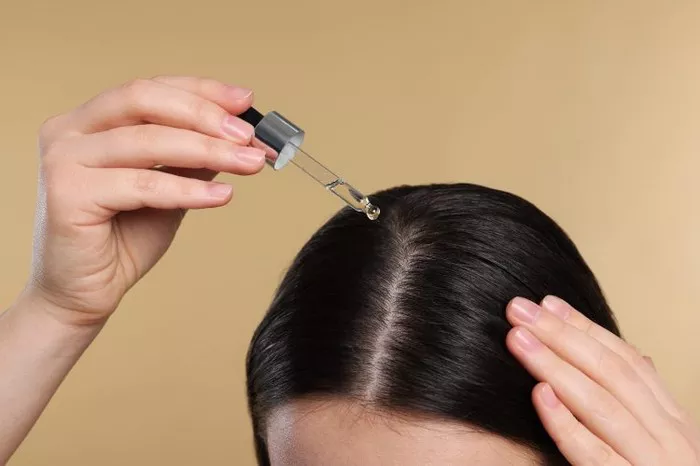Before the age of social media influencers and trendy haircare products, the ultimate hair goals were set by the classic hair infomercials. These featured supermodels with shiny, healthy hair flowing effortlessly in slow motion—leaving us all dreaming of having hair like that. While this dream is still common, achieving it starts with proper scalp care—the foundation from which our hair grows.
“Our scalp skin ages 12 times faster than the rest of the body,” explains Nicole Pidherny, scalp education expert and founder of Pomme Salon. “This doesn’t mean it gets wrinkled, but it loses its natural microbiome quicker and becomes dehydrated. This impacts the hair bulb located in the follicle on our scalp.” Many common hair problems like oiliness, itchiness, and frizz actually begin at the scalp.
For Nikita Mehta, co-founder of Ayurvedic haircare brand Fable & Mane, scalp health is an essential part of her brand. Drawing inspiration from Ayurvedic principles, she explains, “Your body is like an upside-down tree. Your scalp is the root, and your hair is the fruit. Nourish the roots first.” Mehta’s brand reflects this philosophy by focusing on products that nourish the scalp with natural ingredients.
In this guide, we’ll walk you through an essential scalp care routine to promote both healthy hair and scalp, along with product recommendations to help you achieve your best hair.
What Makes a Healthy Scalp?
A healthy scalp should be free from irritation, redness, or discomfort. “If your scalp hurts to touch or feels sensitive when brushing, that’s a sign of an unhealthy scalp,” explains Pidherny. A balanced scalp has healthy circulation, a thriving microbiome, and a mixture of probiotics and microorganisms. To support this balance, it’s important to use products that nourish the scalp with vitamins and natural ingredients.
Step 1: Nourish with Hair Oil
Start your weekly scalp care routine with a nourishing scalp massage using your favorite hair oil. This step helps stimulate blood flow to the scalp and loosens any buildup. “Oil removes oil,” says Pidherny, meaning it helps to draw out excess oils and impurities from the scalp. Apply the oil in sections, depending on your hair’s thickness, and massage it into your scalp. Mehta prefers to use her hands instead of a silicone massager to stimulate circulation. If desired, you can use a facial steamer to help the oil penetrate deeper into the scalp. Let the oil sit for at least 15 minutes, or longer if possible.
Step 2: Exfoliate with Scalp Scrub
After massaging your oil into the scalp, move on to a scalp scrub to exfoliate. Products with ingredients like salicylic acid are ideal for gently removing buildup and dead skin cells. This step ensures that your scalp is thoroughly cleansed and your follicles are free from debris that might hinder hair growth. The act of scrubbing also continues to promote healthy blood circulation.
Step 3: Double Shampoo for Deep Clean
Pidherny suggests double-shampooing to ensure a thorough cleanse. Start with a scalp-focused shampoo to clean the scalp, followed by a second shampoo formulated for your specific hair needs (e.g., for moisture, strength, or color protection). “It’s like washing your scalp and then washing your hair,” says Pidherny, ensuring that both areas are properly cared for.
Step 4: Condition and Detangle
After shampooing, apply conditioner to both your hair and scalp. Contrary to popular belief, conditioning your scalp won’t make your hair greasy. In fact, Pidherny emphasizes that moisturizing the scalp is key to maintaining balance and preventing oil buildup on the scalp. After conditioning, detangle your hair gently.
Step 5: Finish with a Scalp Serum
Once you’ve washed and conditioned your hair, finish with a scalp serum to nourish and stimulate the scalp. Pidherny recommends applying the serum at least three times a week. Applying the serum before bed allows the scalp to absorb the nourishing ingredients while you sleep, as the skin regenerates more effectively overnight. Use a brush with scalp-stimulating bristles as you apply the serum to enhance the effects.
What to Avoid in Scalp Care
To maintain a healthy scalp, it’s essential to avoid a few common mistakes. Pidherny stresses that skipping brushing is one of the most damaging things you can do. Brushing helps distribute natural oils from the scalp to the hair and keeps the scalp stimulated. Additionally, avoid tight hairstyles that stress the scalp, especially when your hair is wet or oiled, as this can cause irritation and damage.
Another key point is to avoid over-scrubbing or over-oiling, both of which can cause irritation or clog pores. Products with strong ingredients like salicylic acid should be used sparingly to avoid disrupting the delicate microbiome of the scalp
Conclusion
Scalp care is crucial to achieving and maintaining healthy hair. Just like the rest of your skin, your scalp needs nourishment and attention to stay balanced and free of buildup. By incorporating regular scalp massages, exfoliation, conditioning, and the use of targeted products, you can create a healthy environment for your hair to thrive. Don’t forget the importance of maintaining a gentle approach—avoid harsh treatments, tight hairstyles, and skipping out on brushing. A little care goes a long way in nurturing your scalp, which ultimately results in stronger, shinier, and more vibrant hair.
Related topics:
- Jennie of Blackpink Unveils Bold Red Hair in “Ruby” Album Trailer
- Mila Kunis Dazzles with Cherry-Cola Red Hair for 2025
- Dyson Unveils Stylish New Colorways for Haircare Tools


